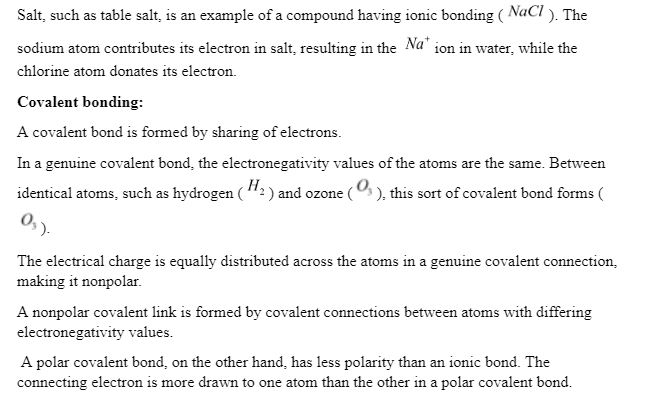Introduction
Chemical bonding is divided into two types: ionic and covalent connections. A chemical bond is an association of two or more atoms or ions.
Ionic bond
One atom donates an electron to another atom in an ionic bond. Both atoms are stabilised as a result of this.
An ionic bond is polar because one atom acquires an electron while the other loses one. In other words, one of the atoms in the bond is positively charged, while the other is negatively charged.
In water, these atoms frequently break down into their ions. The electronegativity values of the atoms involved in ionic bonding differ from one another. Ionic bonding occurs between metals and nonmetals, as evidenced by a table of electronegativity values.

What are sigma and pi bonds?
The strongest sort of covalent link is a sigma bond. When two or more atoms share electrons along a straight line between them, they create a molecule. Pi bonds are weaker than sigma bonds, and they form when two atoms share a pair of electrons laterally.
The sigma orbital is a uniform, dumbbell-shaped orbital located on the molecule’s plane. The electron pairs in the sigma orbital are evenly distributed amongst the two atoms.
When two orbitals on two distinct atoms collide, a pi connection is produced.
The two orbitals are in the same plane and are oriented in the same way.
Strength of sigma and pi bonds
The degree of orbital overlap along the same axes is always higher than the amount of orbital overlap at an inclination. In addition, the stronger the covalent connection is, the more orbitals overlap.
The co-axial overlapping of atomic orbitals forms a sigma bond. The bond entails higher energy evolution than the Pi bond due to the significant overlap of atomic orbitals. The bond entails higher energy evolution than the Pi bond due to the significant overlap of atomic orbitals. In this bond, the charge distribution between two nuclei on the internuclear axis is very significant.
Lateral or side to side overlap of atomic orbitals forms a pi bond. The bond involves less energy evolution than the sigma bond due to less overlap of atomic orbitals. The charge distribution is larger along each internuclear axis than on the nuclear axis in the case of a pi bond.
Bond counting
The need is to know how many triple, double, and single bonds are there in the molecule before you can count sigma pi bonds. One sigma bond exists in a single bond.
The sigma bond in ethane, for example, is formed by the head-on overlap of two types of orbitals.
Conclusion
The sigma bond is a link established among atoms in a molecule by s orbitals overlapping along the axis that connects the connected nuclei. It is the first one to generate, and its stability is determined by how the electrons in the sigma bonding and antibonding orbitals are arranged. Pi bonds are molecular connections created when the p orbitals of different atoms overlap. The electrons that makeup pi bonds will be spread above and below the axis that connects the linked atoms’ nucleus, but not along with it. The bonding and antibonding pi orbitals have a role in the stability of these connections.
 Profile
Profile Settings
Settings Refer your friends
Refer your friends Sign out
Sign out













